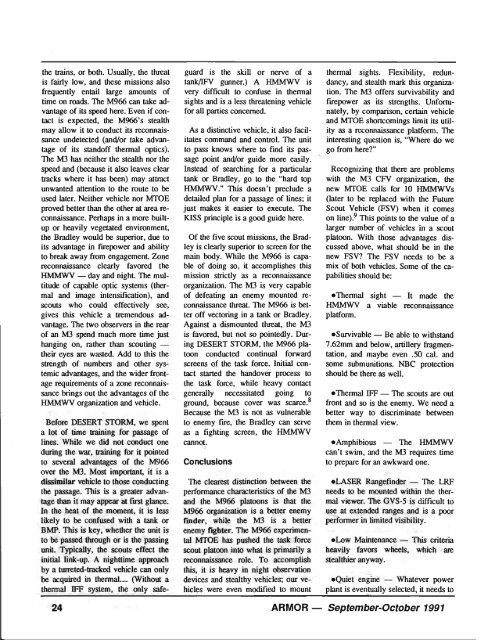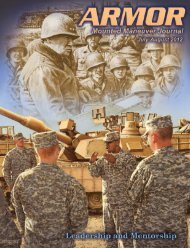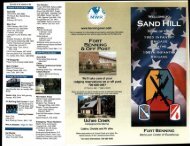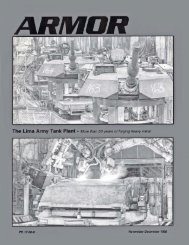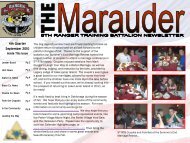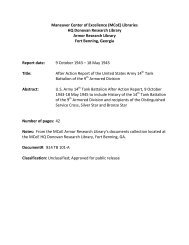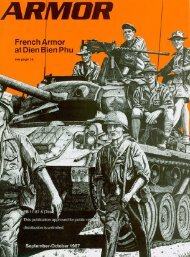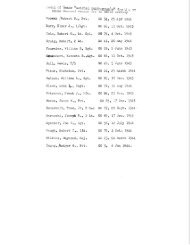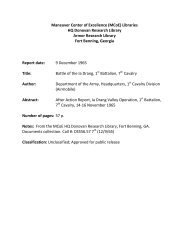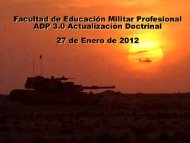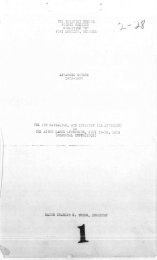ARMOR, September-October 1991 Edition - Fort Benning - U.S. Army
ARMOR, September-October 1991 Edition - Fort Benning - U.S. Army
ARMOR, September-October 1991 Edition - Fort Benning - U.S. Army
Create successful ePaper yourself
Turn your PDF publications into a flip-book with our unique Google optimized e-Paper software.
the trains, or both. Usually, the threat<br />
is fairly low, and these missions also<br />
frequently entail large amounts of<br />
time on roads. The M966 can take ad-<br />
vantage of its speed here. Even if con-<br />
tact is expected, the M966’s stealth<br />
may allow it to conduct its reconnais-<br />
sance undetected (andor take advan-<br />
tage of its standoff thermal optics).<br />
The M3 has neither the stealth nor the<br />
speed and (because it also leaves clear<br />
tracks where it has been) may attract<br />
unwanted attention to the route to be<br />
used later. Neither vehicle nor MIOE<br />
proved better than the other at area re-<br />
connaissance. Perhaps in a more built-<br />
up or heavily vegetated environment,<br />
the Bradley would be superior, due to<br />
its advantage in firepower and ability<br />
to break away from engagement. Zone<br />
reconnaissance clearly favored the<br />
HMMWV - day and night. The mul-<br />
titude of capable optic systems (ther-<br />
mal and image intensification), and<br />
scouts who could effectively see,<br />
gives this vehicle a tremendous ad-<br />
vantage. The two observers in the rear<br />
of an M3 spend much more time just<br />
hanging on, rather than scouting -<br />
their eyes are wasted. Add to this the<br />
strength of numbers and other sys-<br />
temic advantages, and the wider front-<br />
age requirements of a zone reconnais-<br />
sance brings out the advantages of the<br />
HMMWV organization and vehicle.<br />
Before DESERT STORM, we spent<br />
a lot of time training for passage of<br />
lines. While we did not conduct one<br />
during the war, training for it pointed<br />
to several advantages of the M966<br />
over the M3. Most important, it is a<br />
dissimilar vehicle to those conducting<br />
the passage. This is a greater advan-<br />
tage than it may appear at first glance.<br />
In the heat of the moment, it is less<br />
likely to be confused with a tank or<br />
BMP. This is key, whether the unit is<br />
to be passed through or is the passing<br />
unit. Typically, the scouts effect the<br />
initial link-up. A nighttime approach<br />
by a turreted-tracked vehicle can only<br />
be acquired in the rmal.... (Without a<br />
thermal IFF system, the only safe-<br />
guard is the skill or nerve of a<br />
tank/IFv gunner.) A HMMWV is<br />
very difficult to confuse in thermal<br />
sights and is a less threatening vehicle<br />
for all parties concerned.<br />
As a distinctive vehicle, it also facil-<br />
itates command and control. The unit<br />
to pass knows where to find its pas-<br />
sage point and/or guide more easily.<br />
Instead of searching for a particular<br />
tank or Bradley, go to the “hard top<br />
HMMWV.” This doesn’t preclude a<br />
detailed plan for a passage of lines: it<br />
just makes it easier to execute. The<br />
KISS principle is a good guide here.<br />
Of the five scout missions, the Brad-<br />
ley is clearly superior to Screen for the<br />
main body. While the M966 is capa-<br />
ble of doing so, it accomplishes this<br />
mission strictly as a reconnaissance<br />
organization. The M3 is very capable<br />
of defeating an enemy mounted re-<br />
connaissance threat. The M966 is bet-<br />
ter off vectoring in a tank or Bradley.<br />
Against a dismounted threat, the M3<br />
is favored, but not so pointedly. Dur-<br />
ing DESERT STORM, the M966 pla-<br />
toon conducted continual forward<br />
screens of the task force. Initial con-<br />
tact started the handover process to<br />
the task force, while heavy contact<br />
generally necessitated going to<br />
ground, because cover was scarce?<br />
Because the M3 is not as vulnerable<br />
to enemy fire, the Bradley can serve<br />
as a fighting screen, the HMMWV<br />
cannot.<br />
Conclusions<br />
The clearest distinction between the<br />
performance characteristics of the M3<br />
and the M966 platoons is that the<br />
M966 organization is a better enemy<br />
finder, while the M3 is a better<br />
enemy fighter. The M966 experimen-<br />
tal rvrrOE has pushed the task force<br />
scout platoon into what is primarily a<br />
reconnaissance role. To accomplish<br />
this, it is heavy in night observation<br />
devices and stealthy vehicles; our ve-<br />
hicles were even modified to mount<br />
thermal sights. Flexibility, redun-<br />
dancy, and stealth mark this organiza-<br />
tion. The M3 offers survivability and<br />
firepower as its strengths. Unfortu-<br />
nately, by comparison, certain vehicle<br />
and MTOE shortcomings limit its util-<br />
ity as a reconnaissance platform. The<br />
interesting question is, “Where do we<br />
go from here?”<br />
Recognizing that there are problems<br />
with the M3 CFV organization, the<br />
new MTOE calls for 10 HMMWVs<br />
(later to be replaced with the Future<br />
Scout Vehicle (FSV) when it comes<br />
on line)? This points to the value of a<br />
larger number of vehicles in a scout<br />
platoon. With those advantages dis-<br />
cussed above, what should be in the<br />
new FSV? The FSV needs to be a<br />
mix of both vehicles. Some of the ca-<br />
pabilities should be:<br />
.Thermal sight - It made the<br />
HMMWV a viable reconnaissance<br />
platform.<br />
*Sllrvivable - Be able to withstand<br />
7.62mm and below, artillery fragmen-<br />
tation, and maybe even .50 cal. and<br />
some submunitions. NBC protection<br />
should be there as well.<br />
.Thermal IFF - The scouts are out<br />
front and so is the enemy. We need a<br />
better way to discriminate between<br />
them in thermal view.<br />
.Amphibious - The HMMWV<br />
can’t swim, and the M3 requires time<br />
to prepare for an awkward one.<br />
.LASER Rangefinder - The LRF<br />
needs to be mounted within the ther-<br />
mal viewer. The GVS-5 is difficult to<br />
use at extended ranges and is a poor<br />
performer in limited visibility.<br />
.Low Maintenance - This criteria<br />
heavily favors wheels, which are<br />
stealthier anyway.<br />
.Quiet engine - Whatever power<br />
plant is eventually selected, it needs to<br />
-<br />
24 <strong>ARMOR</strong> - <strong>September</strong>-<strong>October</strong> 7997


